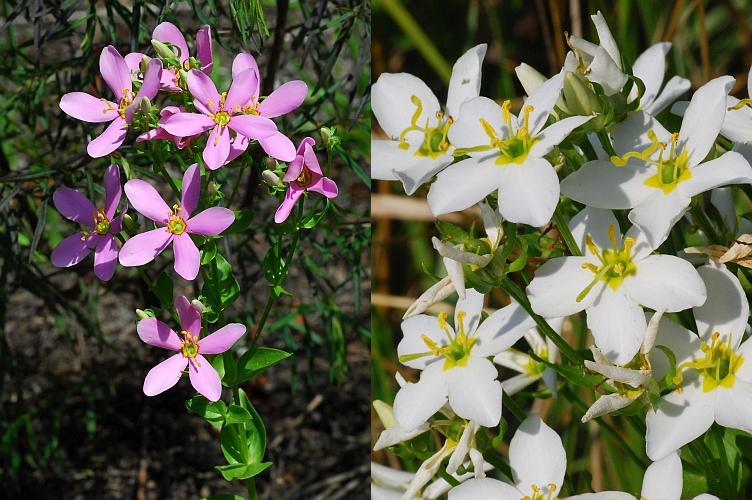Sabatia angularis (L.) Pursh
Rose-Pink

Native
CC = 4
CW = 0
MOC = 58
© SRTurner
Sabatia angularis (L.) PurshRose-Pink | |
 |
Native CC = 4 CW = 0 MOC = 58 |
© SRTurner |
|
Family - Gentianaceae Habit - Annual or biennial forb. Stem - Erect, to 80 cm, glabrous, nearly square in cross-section and winged, at least in the lower half, the branches mostly opposite.
Leaves - Opposite, simple, sessile, entire, ovate, widest near the rounded to cordate, clasping bases, 3-7-nerved, 15-40 mm long, glabrous.
Inflorescence - Terminal open panicles, sometimes reduced to loose clusters.
Flowers - Usually 5-merous. Calyces deeply lobed, not or inconspicuously ribbed, 8-20 mm long, the lobes linear or rarely somewhat oblong, 9-18 mm long. Corollas saucer-shaped, pink to white, with a yellow spot at the base of each lobe, the lobes spathulate to elliptic, 10-22 mm long, 3-5 times as long as the short tube. Anthers spirally coiled after dehiscence. Ovaries sessile, the style slender, elongate, the stigma deeply 2-lobed.
Fruits - Capsules, ovoid to cylindrical.
Flowering - June - September. Habitat - Glades, forest openings, streambanks, prairies, fens, pastures, fields, roadsides. Origin - Native to the U.S. Lookalikes - None. Other info. - This attractive plant is common across most of the southeastern 2/3 of Missouri. Its wider distribution is predominantly within the southeastern continental U.S., with scattered populations extending farther north and into Canada. Photographs taken at LaBarque Creek Conservation Area, Jefferson County, MO, 07-18-2016, Shaw Nature Reserve, Franklin County, MO, 07-20-2007, and Klondike County Park, St. Charles County, MO, 07-30-2016 (SRTurner). |